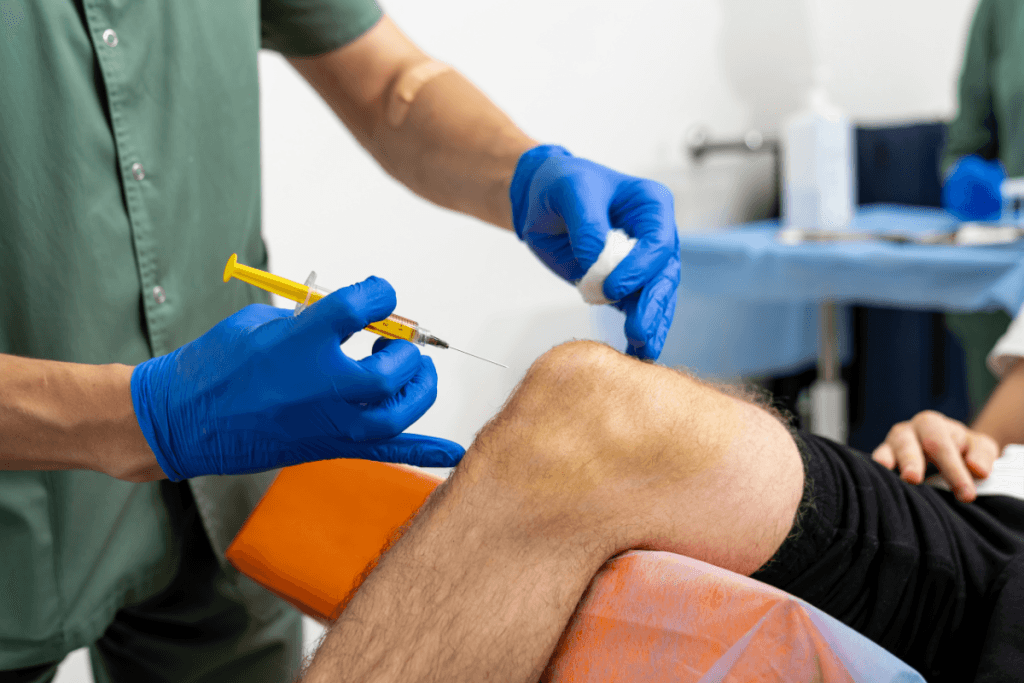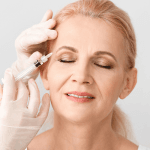Knee pain affects over 1 in 4 adults in the United States, and it’s one of the leading causes of disability among older populations. Osteoarthritis (OA), a degenerative joint disease, is the most common culprit. With no cure available, many patients turn to non-surgical pain relief methods like gel injections to delay or avoid joint replacement surgery.
Gel injections have become a cornerstone in joint pain treatment, especially for those with mild to moderate knee osteoarthritis. As more people seek alternatives to oral painkillers and steroid shots, this therapy continues to grow in popularity for its targeted relief and minimally invasive approach.
This article breaks down the types of gel injections for knees available today, from standard hyaluronic acid therapy to advanced cross-linked gels and PRP (platelet-rich plasma) combinations. We’ll explore how each option works, who it’s best for, and what to expect.
What Are Knee Gel Injections?
Gel injections, medically referred to as viscosupplementation, involve injecting a lubricating substance, typically hyaluronic acid (HA), directly into the knee joint. Hyaluronic acid is a naturally occurring fluid in the joints that helps cushion and lubricate movement. In people with osteoarthritis, HA levels are often depleted, leading to stiffness, friction, and pain. By restoring this lubrication, gel injections can reduce inflammation, improve mobility, and delay the need for surgery.
1. Traditional Hyaluronic Acid Injections
This is the most widely used and studied form of knee gel injection. These injections contain non-crosslinked hyaluronic acid derived from either animal sources (like rooster combs) or synthetic manufacturing. Once injected, the HA supplements the joint fluid, enhancing its shock-absorbing properties.
Brand Names:
Who It’s For: Best for people with mild to moderate knee osteoarthritis, especially if oral medications or physical therapy haven’t provided enough relief.
Pros:
- FDA-approved for knee OA
- Generally well tolerated
- Some insurance plans cover it
Cons:
- Effects can be temporary (typically 4–6 months)
- Requires 1 to 3 injections, depending on the brand
- May not work for severe arthritis
This is one of the best knee gel injections therapies for first-time patients.
2. Cross-Linked Hyaluronic Acid Formulations
Cross-linked HA formulations are a more advanced type of gel injection designed to last longer in the joint. Cross-linking refers to a chemical process that binds HA molecules together, making the gel thicker and more resistant to breakdown. The result is a more durable, longer-lasting lubricant inside the joint.
Brand Names:
Who It’s For: Ideal for active patients or those with moderate arthritis who want longer relief with fewer injections.
Pros:
- Usually requires only one injection
- May last up to 6–9 months
- Some studies show improved pain relief over traditional HA
Cons:
- Higher out-of-pocket costs
- Not always covered by insurance
- Not effective in all patients
This formulation represents the next evolution in viscosupplementation for knee osteoarthritis.
3. Platelet-Rich Plasma (PRP) + Hyaluronic Acid Combination Injections
This emerging option combines PRP therapy with HA for a regenerative and lubricating treatment in one. PRP involves drawing a small amount of your blood, spinning it to isolate growth factors, and injecting it back into the joint. When combined with HA, it delivers anti-inflammatory and healing benefits while also restoring lubrication.
Brand Names:
- RegenLab PRP-HA
- CellularMatrix
- Custom-mixed options from orthopedic or regenerative clinics
Who It’s For: Often used in younger or more active patients with early-stage OA or those looking for alternatives to corticosteroids.
Pros:
- Natural, regenerative option
- May promote healing in cartilage and soft tissue
- Can reduce joint stiffness and improve mobility
Cons:
- Not FDA-approved for OA (off-label use)
- Expensive and usually not covered by insurance
- Results vary depending on individual biology
This hybrid approach is gaining popularity in treatment for joint pain and stiffness among athletes and patients seeking non-invasive, long-term solutions.
4. Customized or Multi-Viscosupplementation Protocols
Some clinics now offer personalized gel injection plans that utilize a combination of HA types or repeated cycles, based on imaging and patient response. Patients may receive a series of injections spaced over weeks or months, combining cross-linked and non-cross-linked HA for optimized results.
Who It’s For: Patients with recurring flare-ups or those who have had partial success with standard treatments.
Pros:
- Tailored to patient needs
- Can delay surgical interventions
- May integrate with physical therapy and bracing
Cons:
- Requires careful follow-up
- Typically out-of-pocket
- Not standardized across providers
Though not widely available, this represents the future of personalized joint pain management.
Clinical-Grade Gel Injections for Knee Osteoarthritis
Explore our selection of FDA-approved gel injections designed for intra-articular treatment of knee osteoarthritis. We offer high-quality hyaluronic acid and cross-linked viscosupplementation products suitable for use in orthopedic, sports medicine, and pain management practices. All products are sourced from trusted manufacturers and available for licensed medical use.
1. Monovisc® (22mg/mL, 1 x 4mL Prefilled Syringe)
Monovisc is a single-injection hyaluronic acid treatment designed to provide long-lasting relief for knee osteoarthritis. It contains a high molecular weight, non-animal sourced HA that integrates with synovial fluid to restore lubrication and reduce joint pain. Ideal for busy practices, Monovisc allows treatment with just one visit per cycle, making it a convenient viscosupplementation option for both patients and providers.
2. Euflexxa® (Italian, 10mg/mL, 3 x 2mL Prefilled Syringes)
Euflexxa is a bioengineered hyaluronic acid injection administered in a three-dose regimen over a period of three weeks. As a non-animal stabilized HA (NASHA), it offers reduced risk of allergic reactions and mimics the body’s natural joint fluid. Clinically proven to relieve knee pain and improve function in patients with osteoarthritis, Euflexxa is especially suited for those who haven’t responded well to oral or topical therapies.
3. Durolane® (20mg/3mL, English)
Durolane is a single-injection, ultra-purified hyaluronic acid designed for deep joint relief in knee osteoarthritis. Using NASHA technology, it offers high viscoelasticity and prolonged residence time in the joint space. Durolane is often preferred for its one-and-done approach and robust clinical support, which has been shown to provide months of symptom relief.
4. Orthovisc® (English)
Orthovisc contains ultra-pure, high-molecular-weight hyaluronic acid derived through bacterial fermentation. It is administered over a series of 3–4 injections, with substantial evidence supporting its efficacy in mild to moderate osteoarthritis cases. Orthovisc is a trusted choice in orthopedic and rheumatologic settings for its proven safety profile and consistent pain reduction.
5. Hymovis® (German, 24mg/3mL, 2 x 3mL Prefilled Syringes)
Hymovis offers a unique formulation with enhanced viscoelastic properties, thanks to its MOVI technology, which enables it to mimic the natural properties of synovial fluid closely. Administered in two injections one week apart, it provides durable cushioning and shock absorption for arthritic joints. Hymovis is especially useful for active patients who need flexible, long-lasting joint support.
How Effective Are Gel Injections for Knee Osteoarthritis?
Results vary, but clinical data support the use of different types of gel injections for knees, especially for early to moderate OA.
- A 2021 review in the Journal of Orthopaedic Research found that viscosupplementation significantly improved pain and function scores at 6 months post-injection.
- A 2023 systematic review also demonstrated that cross-linked HA provided better sustained relief compared to non-cross-linked versions.
That said, the American Academy of Orthopaedic Surgeons (AAOS) has mixed recommendations, citing that benefits may be modest and patient-specific.
Are Gel Injections Safe?
Yes, most are well-tolerated with minimal side effects. Common side effects include:
- Mild swelling or pain at the injection site
- Temporary stiffness
- Rare allergic reactions (especially with animal-derived HA)
Infections or serious complications are rare, primarily when procedures are performed in sterile, clinical environments.
Who Should Avoid Gel Injections?
Gel injections may not be ideal for:
- People with severe bone-on-bone OA
- Those with a known allergy to hyaluronic acid or avian proteins
- Individuals with active joint infections
- Patients are already scheduled for imminent knee replacement
Always consult with a board-certified orthopedic or sports medicine physician to evaluate suitability.
Conclusion
With rising cases of osteoarthritis and an aging population, the demand for non-surgical joint pain management continues to grow. The types of gel injections for knees now extend far beyond basic hyaluronic acid, offering more targeted, longer-lasting, and regenerative options for relief.
Whether you’re just starting to explore your options or you’re frustrated with steroid injections, understanding the available knee gel therapy can help you make informed decisions that align with your lifestyle and condition. Consult with your doctor to determine the most suitable knee gel injection for your individual needs.
Frequently Asked Questions (FAQs)
Can I drive after receiving a knee gel injection?
Yes, most people can drive themselves home after the procedure, especially if only one knee is treated. However, mild stiffness or soreness might affect your reaction time. If you’re unsure, ask your doctor before leaving the clinic.
Do I need to rest after getting a gel injection?
You can usually resume light activities the same day, but it’s best to avoid high-impact movements for 48 hours. Letting your knee settle can help the gel distribute more effectively. Follow your doctor’s post-injection instructions for best results.
How many times can I get gel injections in a year?
Most treatments are spaced every 6 months, but the exact frequency depends on the product and how your body responds. Repeated injections are generally safe if administered at appropriate intervals. Your provider will create a schedule based on your symptoms and insurance coverage.







